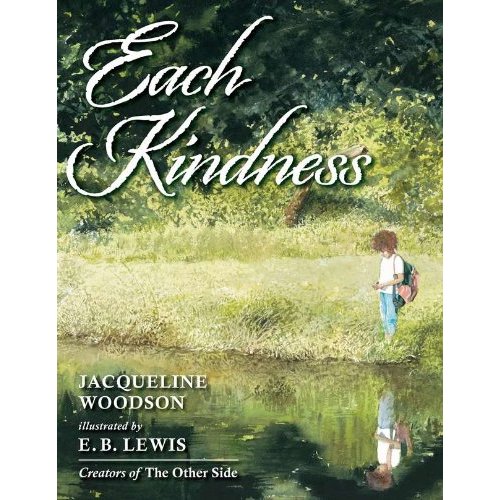

Each Kindness Makes the World a Better Place…Inside or Outside of the Classroom.
Each Kindness
By Jacqueline Woodson, illustrated by E.B. Lewis
Young readers have not been in school, in the conventional sense, for several months.
And with this change in how teaching comes about, technology, and its use, is appearing to play a bigger role in long-distance learning because of the Covid-19 pandemic.
And along with this new normal there is, I am pretty sure, a huge uptick in the use of social media platforms, because young people are still communicating with one another for learning and interacting with one another; hopefully in positive ways.
But, as civil discourse coarsens in the culture, so also does the discourse on places like Facebook which parents use, but the younger set, probably not, as who would want to be on social media that ones parents use?
They’re probably on Tik Tok.
Bullying certainly does take place in school. It just has found a new outlet with the onset of technology and the ability to be more widely disseminated.
Lately, two books on bullying seem to have caught my interest as the topic is drawn daily from the pages of newspapers with the intensity and relentlessness of an activity becoming ever more acute in our schools.
The one from 1946 is called The Hundred Dresses by Eleanor Estes and the other from 2012 is Bully by Patricia Polacco. Both are potent portents of thought for young readers in that they provoke conversation for parents and children. “The more things change, the more they stay the same” or “Nothing new under the sun”. Those are the quotes that spring to mind when we see negative behaviors repeated one generation to the next? If you read The Hundred Dresses, and then Each Kindness, you will see what I mean.
I ask myself, looking back on my own childhood, having endured my own share of teasing, as it was termed then, are children less resilient today or have we failed in some way to short circuit bullying through emphasizing the power and long reaching effect of simple acts of kindness whether by their commission or omission?
There is definitely something to be said for the teaching and modeling of a common core of values.
In our fast forward culture’s increasing emphasis on academic excellence, are we losing something very valuable in that emphasis?
How do we teach and model things like empathy, kindness, compassion, sensitivity to another child different from who we are?
So today I find myself in the easy company of an uplifting picture book with a powerful message and it’s called Each Kindness. Maybe you will feel the pull of this book, too, as perhaps you have with some of Ms. Woodson’s other titles such as The Other Side, an ALA notable book, Coming on Home Soon, a Caldecott Honor book or Pecan Pie Baby, Horn Book Honor Book. If not, I hope you do.
In Each Kindness, to be the new child in class is tough enough, as young Maya discovers. But, adding in old and ragged school clothes, a broken strap on a shoe and what seems to other kids, unfamiliar lunch food, causes friends Chloe, Kendra and Sophie to rebuff Maya’s attempts at entering into a friendship. Her offer to share a game of jacks is met with refusal. Ah, kids can be a tightknit band and downright cruel, let’s face it, when they want to be.
As the weather warms and Maya wears a pretty dress and fancy shoes to school, her peers immediately decide they came from a secondhand store and Kendra dubs Maya with a new name – “Never New” followed by laughter from the trio. This time Maya jumps with her rope alone and does not even look at her agitators.
The next day Maya is not in school where Ms. Albert’s lesson is about kindness, illustrated by each child dropping a small stone into a big bowl of water and watching the ripple effect spread. Each child drops a stone in as they relate a kind act they’ve done and watch the water ripple outward and spread.
But Chloe does not take her turn with the stone, as she struggles to recall a recent good deed, remembering the words of her teacher, “Each kindness makes the world a better place.”
Maya does not return to school as the children are informed her family had to move away as Chloe’s throat is filled with all the things she left unsaid to Maya’s offerings of friendship. As she stands near a pool of water tossing stone after stone into it, she recounts the missed opportunities that cannot be recaptured and the chances to do or say something good left undone.
Chloe perhaps will sit with that feeling for a while and that is not a bad thing, for there will be other Maya’s in Chloe’s young life where, from this experience of regret she will not let the chance for a kindness by another to pass by unnoticed or a kindness from her to be left undone.
Hold your head high, Maya, and Chloe, there will be a second chances to do some kindness in the world and please remember Maya when you do them. Kindness is important in its commission but needs to be paid more attention to in its omission or missed opportunities. Each Kindness is an excellent and powerful reminder to young readers for the need to identify chances for both.
